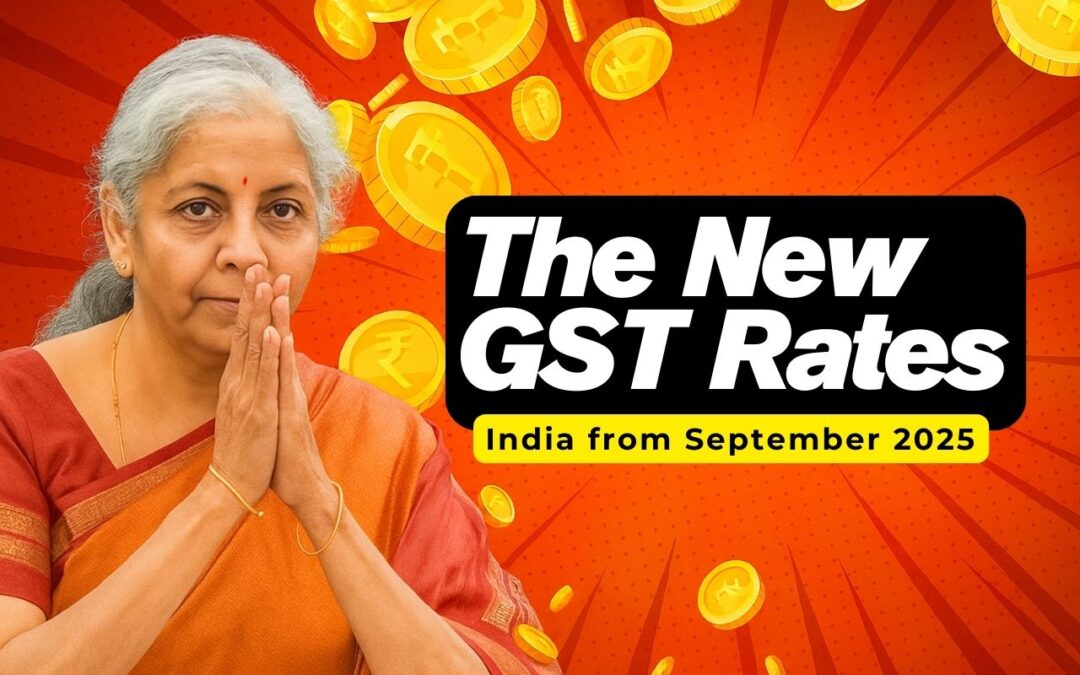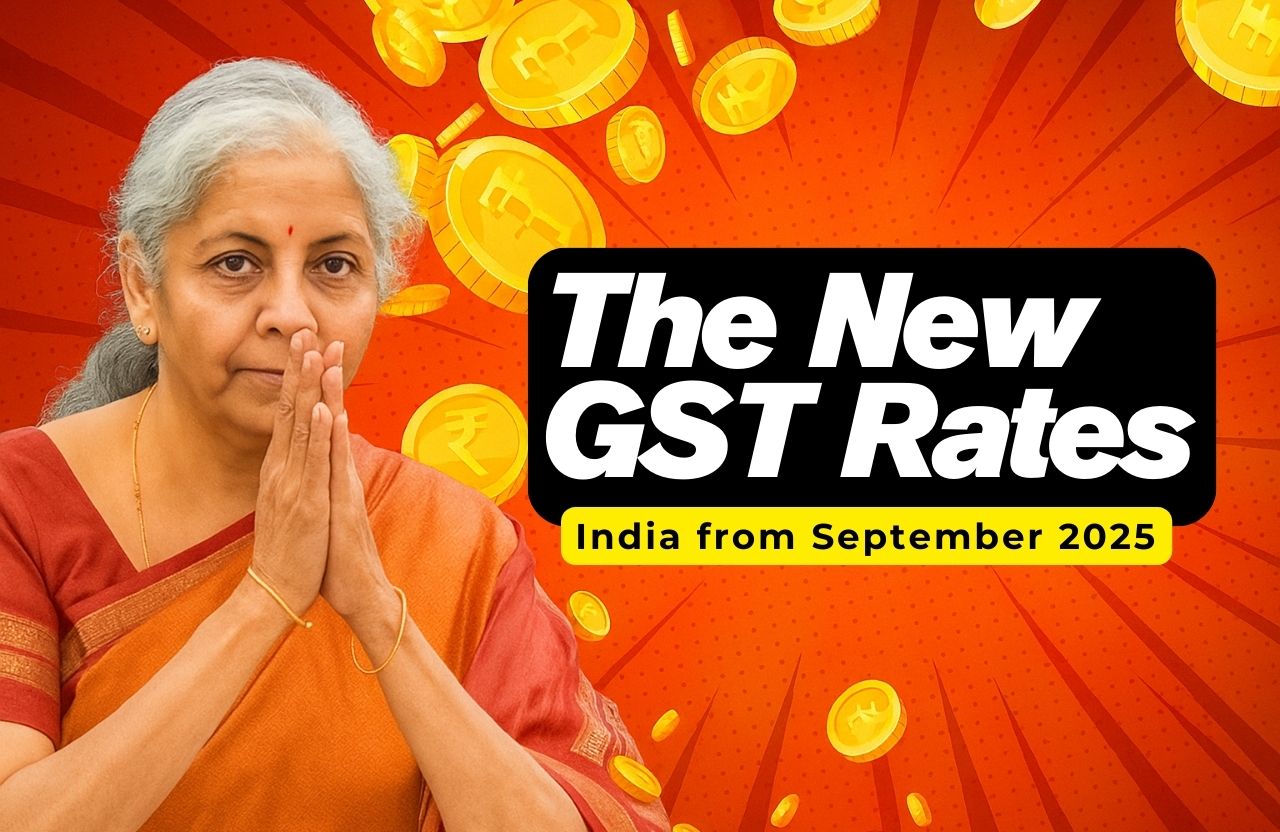Taxes don’t usually come up at the family dinner table but the newly announced GST rates in India in September 2025 are important for almost every household and business overall.
You might ask “why?” Not only are the rates changing but the rates affect everything from the grocery bill to the price of your next car.
On September 22, 2025, the government officially launched a reorganized GST system, which takes India’s convoluted tax structure and puts it into a simplified structure with two main slabs, 5% and 18% and a third slab for sin and luxury goods at 40%. Some basic items were even moved to the 0% tax slab.
This change is alleged to be the largest change in GST since its inception in 2017 and may impact how Indians spend, save and do business going forward.
What Is the New GST Structure in India From September 2025?
Compared to this change, GST previously had four prominent slabs: 5%, 12%, 18% and 28%, as well as compensation cess. Many suggested it was too complicated and hence had confusion and compliance issues.
From September 2025, that clutter is gone. Now, the GST structure looks like this:
- 0% GST → For everyday essentials like UHT Milk, paneers, roti, and parathas.
- 5% GST → For medicines, medical devices, food products like cheese, butter and fruit juices.
- 18% GST → For cars, appliances, construction materials, textiles and fertilizers.
- 40% GST → For sin and luxury goods, including tobacco, pan masala, casinos, betting and online gaming.
The government says this new approach makes GST simpler, fairer and more consumer-friendly.
Which Essentials Are Cheaper or Tax-Free Under the New GST Rates in India From September 2025?
Completely Tax-Free (0% GST)
Some of the items you might use daily are now exempt from GST, including:
- UHT milk
- Paneer
- Roti
- Parathas
- Pizza bread
- Khakra and similar snacks
This step is designed to assist in making basic food items accessible and affordable for all people, particularly middle and lower-income families.
Reduced to 5% GST
Products that earlier attracted 12–18% GST now come under the 5% bracket. These include:
- Medicines and medical devices (bandages, diagnostic kits, gauze).
- Butter
- cheese and condiments.
- Fruit juices, dates, nuts and soya milk.
- Nutritional supplements.
This should reduce household spending on health, wellness and everyday grocery items.
Which Products will Fall Under the 18% GST Slab From Sep 2025?
Not everything got cheaper. But some big-ticket items have moved into the 18% category from the earlier 28% bracket. This covers:
- Electronic Appliance’s: Air conditioners, televisions and dishwashers.
- Automobiles: Cars (petrol ≤1200 cc, diesel ≤1500 cc, length ≤4 m) motorcycles ≤350 cc.
- Industrial & construction materials – cement, steel.
- Agricultural machinery: lowering costs for farmers.
- Textiles and fertilizer inputs: which helps both industries and consumers.
For middle-class families, this means cars, bikes and appliances could become more affordable. For industries, it means lower input costs.
What Items Are Taxed at 40% in the New GST Slabs 2025?
One of the most striking parts of the new GST rates in India from September 2025 is the introduction of 40% slabs. This applies to:
- Cigarettes, gutkha, pan masala, bidi and unmanufactured tobacco.
- Lotteries, casinos, horse racing.
- Online gaming and betting platforms.
The reasoning is simple: discourage harmful consumption and tax luxury indulgences more heavily. This higher rate also helps the government maintain revenue while cutting taxes elsewhere.
Why Did the GST Council Introduce the New GST Rates in India From, September 2025?
The government didn’t make these changes overnight. Here’s why the new GST slabs were introduced:
- Simplicity – Minimum slabs means less compliance and confusion for businesses.
- Correcting inverted duty structures – Industries like textiles and fertilizers earlier paid higher tax on inputs than on final products. The new slabs fix that.
- Encouraging spending – Cheaper food, medicines and appliances should boost consumption.
- Supporting small businesses – Compliance is expected to get easier, especially with simplified GST registration for small suppliers on e-commerce platforms.
- Revenue neutrality – Even with cuts, the new structure is expected to balance out, with about ₹48,000 crore in net revenue adjustments.
What It Means for Businesses
While the changes bring potential opportunities they also present challenges.
- E-way bills: no more bill is required for goods that are already in-transit.
- Input Tax Credit (ITC): Businesses may need to adjust credits for exempt goods but can claim refunds more easily for inverted duty structures.
- System updates: Firms will have to update their IT systems, change their pricing and change their contracts.
- More streamlined registration: Small sellers on e-commerce portals will avail benefits from the simplified scheme for GST registration.
On some level, the initial walk-through of the implementation may not be clear sailing and transitioning, but over a longer term, businesses (including e-commerce) will find the new regime easier to work with.
Consequences for Customers and for the Economy
Therefore, moving into September 2025, India, what are the new GST rates and what does it mean for you personally?
- Households: Cheaper daily groceries, medicines and essentials.
- Middle-class families: Cars, bikes or electronics will now be less expensive.
- Farmers: Agricultural machinery and fertilizers are cheaper and this has reduced operating costs.
- Industries: Construction, textiles and real estate may see growth.
- Government finances: Revenue has remained stable, mainly due to 40% tax on sin tax and luxury goods.
Experts claim that this may be a boost for growth in consumption and industry, but all depends on the implementation running smoothly.
Conclusion
The new GST rates in India from September 2025 are being hailed as a bold reform.
With a smaller number of slabs, a tax-free category for essential goods and lowered rates on health care and everyday items, the new system feels quite consumer-friendly. Meanwhile, higher taxes on ‘sin’ products and luxury goods keep taxes flowing smoothly to government coffers.
The big question is whether consumers will really receive this benefit of lower prices or factor in inflation, compliance issues, disputes and ultimately cash in only a little short of today’s transaction. Only time will tell.
FAQs on New GST Rates in India From September 2025
Q1. When are the new GST rates effective from?
They apply from September 22, 2025 with slabs of 0%, 5%, 18% and 40%.
Q2. What are the new GST slabs?
0%, 5%, 18% and 40%.
Q3. What’s now tax-free?
UHT Milk, paneers, roti, parathas, pizza bread and khakras.
Q4. Which items are at 5% GST?
Medicines, medical devices, butter, cheese, condiments, nuts, dates, fruit juices and soya milk etc.
Q5. What’s under the 18% slab?
Appliances, small cars, motorcycles under 350 cc, cement, steel, textiles and fertilizers.
Q6. What falls under 40% GST?
Tobacco products, pan masala, lotteries, casinos, betting, online gaming.
Q7. Do e-way bills need to be updated?
No, existing ones remain valid.
Q8. How does this impact ITC (Input Tax Credit)?
ITC on exempt goods may need adjustment, but refunds for inverted duty structures will improve.
Q9. What is the impact on government revenue?
The new regime will supposedly even out with ₹48,000 crore in net revenue adjustments.
Q10. Will small businesses find compliance easier?
Yes, simplified registration for e-commerce suppliers is expected soon.
Q11. Are tobacco items included in the tax cuts?
No, they’re excluded and heavily taxed at 40%.
Q12. How will common people benefit?
Cheaper essentials, lower costs on medicines, appliances and even small vehicles.













